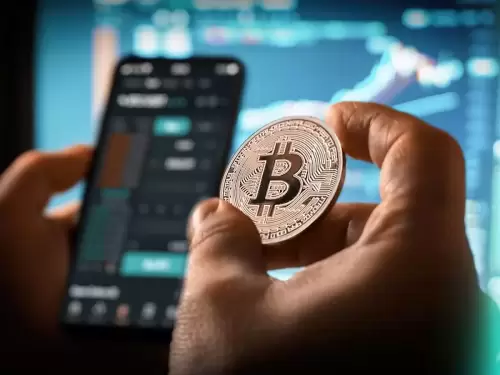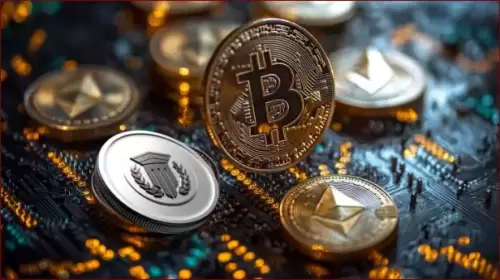 |
|
 |
|
 |
|
 |
|
 |
|
 |
|
 |
|
 |
|
 |
|
 |
|
 |
|
 |
|
 |
|
 |
|
 |
|
Cryptocurrency News Articles
Bitcoin's Market Supply and Prices: A New Yorker's Take
Jun 29, 2025 at 05:00 pm
Dive into the dynamic world of Bitcoin's market supply and prices, influenced by halving events, mining costs, regulation and market sentiment.

Bitcoin's Market Supply and Prices: A New Yorker's Take
Alright, let's talk Bitcoin. It's not just some digital fad anymore; it's a serious player in the global financial game. Understanding what drives its market supply and prices is key, especially with all the noise out there. Think of it as navigating the city streets – you gotta know the shortcuts and the traffic patterns.
Bitcoin Halving: The Four-Year Frenzy
Every four years or so, Bitcoin does this thing called 'halving.' Basically, the reward for mining new blocks gets cut in half. This slows down the rate at which new Bitcoins are created, making them scarcer. It's like Bitcoin's way of mimicking gold – limited supply, potentially higher value. Historically, these halvings have led to some wild price surges. After the 2012 and 2016 halvings, Bitcoin went on crazy bull runs, hitting all-time highs. The anticipation alone can drive up investor hype and demand.
Mining: Not Just Digging in the Digital Dirt
Mining Bitcoin involves solving complex math problems to validate transactions. As more miners jump in, these problems get harder, adjusting every 2016 blocks to keep things steady. This means mining becomes more expensive as the network grows. The cost of mining has a big impact on Bitcoin's price. If it gets too expensive to mine (due to energy costs or competition), miners might sell their newly mined coins to cover expenses. If Bitcoin's price doesn't rise enough to cover these costs, miners might lose interest, decreasing the supply. On the flip side, if mining is profitable, more miners could join, increasing the supply.
Market Demand: It's All About the Hype
Demand for Bitcoin is driven by a bunch of things: market sentiment, investor speculation, and overall economic trends. When more investors want Bitcoin, the price goes up. Big events like institutional investments, regulatory changes, and technological advancements can really shake things up. For example, when companies like MicroStrategy and Tesla started buying Bitcoin, it gave the cryptocurrency more credibility, and retail investors followed suit, driving demand even higher.
Regulations: The Wild Card
Regulations play a huge role in Bitcoin's supply and price. Governments and regulatory bodies worldwide are constantly trying to figure out how to handle Bitcoin and other cryptocurrencies. Regulatory news can directly impact Bitcoin prices. Positive news, like the approval of Bitcoin ETFs or clearer regulatory guidelines, can boost investor confidence and demand. Negative news, like government crackdowns or restrictions on cryptocurrency trading, can cause panic selling and decreased demand.
Tech and Macroeconomics: The Bigger Picture
Bitcoin's technology is always evolving. Improvements like the Lightning Network aim to improve scalability and transaction speed, which can boost investor confidence. Also, broader economic conditions like inflation, interest rates, and geopolitical tensions can influence investor behavior. In times of economic uncertainty, people might turn to Bitcoin as a store of value, driving up demand and prices.
Investor Psychology: The Fear and the Greed
Investor psychology is crucial in the cryptocurrency market. Fear of missing out (FOMO) and fear, uncertainty, and doubt (FUD) can cause extreme price swings. During bull markets, positive sentiment can create a self-fulfilling prophecy, where rising prices attract more buyers, pushing the price even higher. Conversely, during bear markets, negative sentiment can lead to mass sell-offs, causing prices to plummet.
Personal Take
Let's be real, navigating the crypto world can feel like rush hour on the L. There's so much happening, it's hard to make sense of it. But projects like Bitcoin Solaris (BTC-S) are trying to cut through the noise by focusing on serious tech and long-term wealth creation. They're not just riding the hype train; they're building something that could actually last. And with features like liquid staking, they're making it easier for everyday users to get involved.
Of course, there's always risk involved. But for those looking to diversify, projects like BTC-S might be worth a closer look.
Final Thoughts: Stay Informed, Stay Smart
So, there you have it. Bitcoin's market supply and price are influenced by a ton of factors, from halving events to regulatory developments and macroeconomic trends. Staying informed can help you make smarter investment decisions. Whether you're a seasoned investor or new to the crypto game, understanding these intricacies can be invaluable. Now, go out there and conquer the crypto world, New Yorker style!
Disclaimer:info@kdj.com
The information provided is not trading advice. kdj.com does not assume any responsibility for any investments made based on the information provided in this article. Cryptocurrencies are highly volatile and it is highly recommended that you invest with caution after thorough research!
If you believe that the content used on this website infringes your copyright, please contact us immediately (info@kdj.com) and we will delete it promptly.





























































